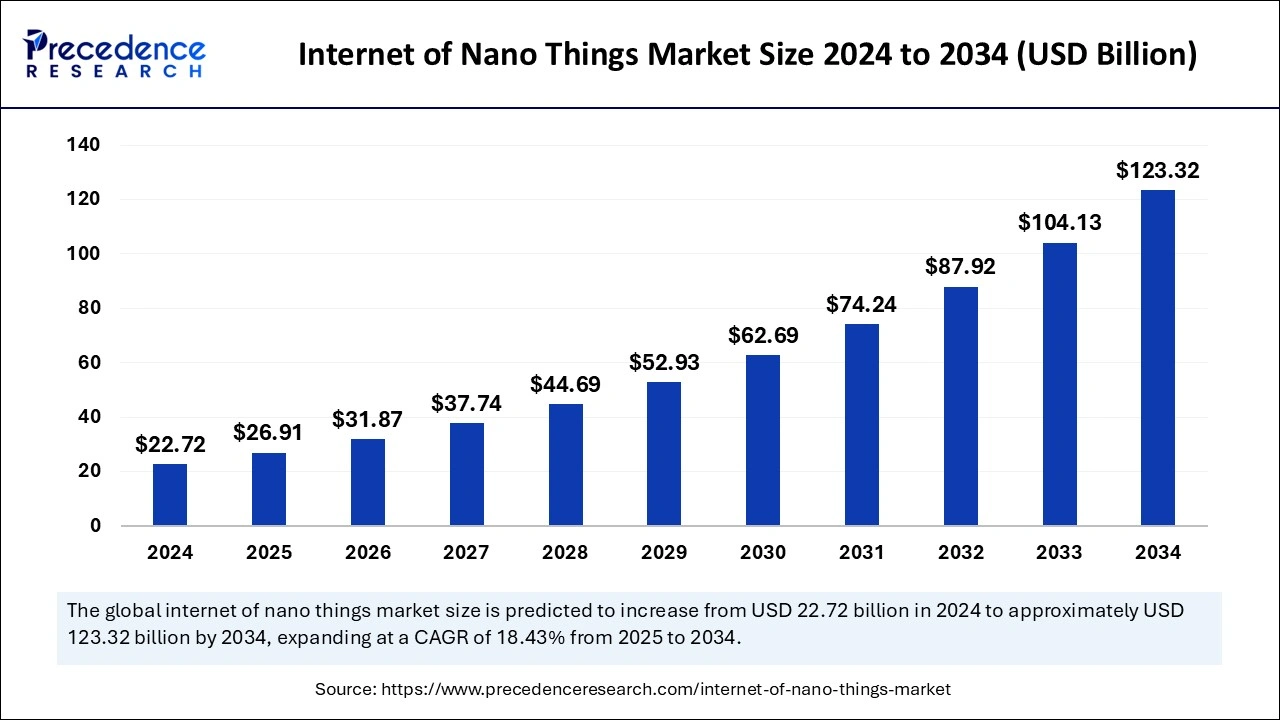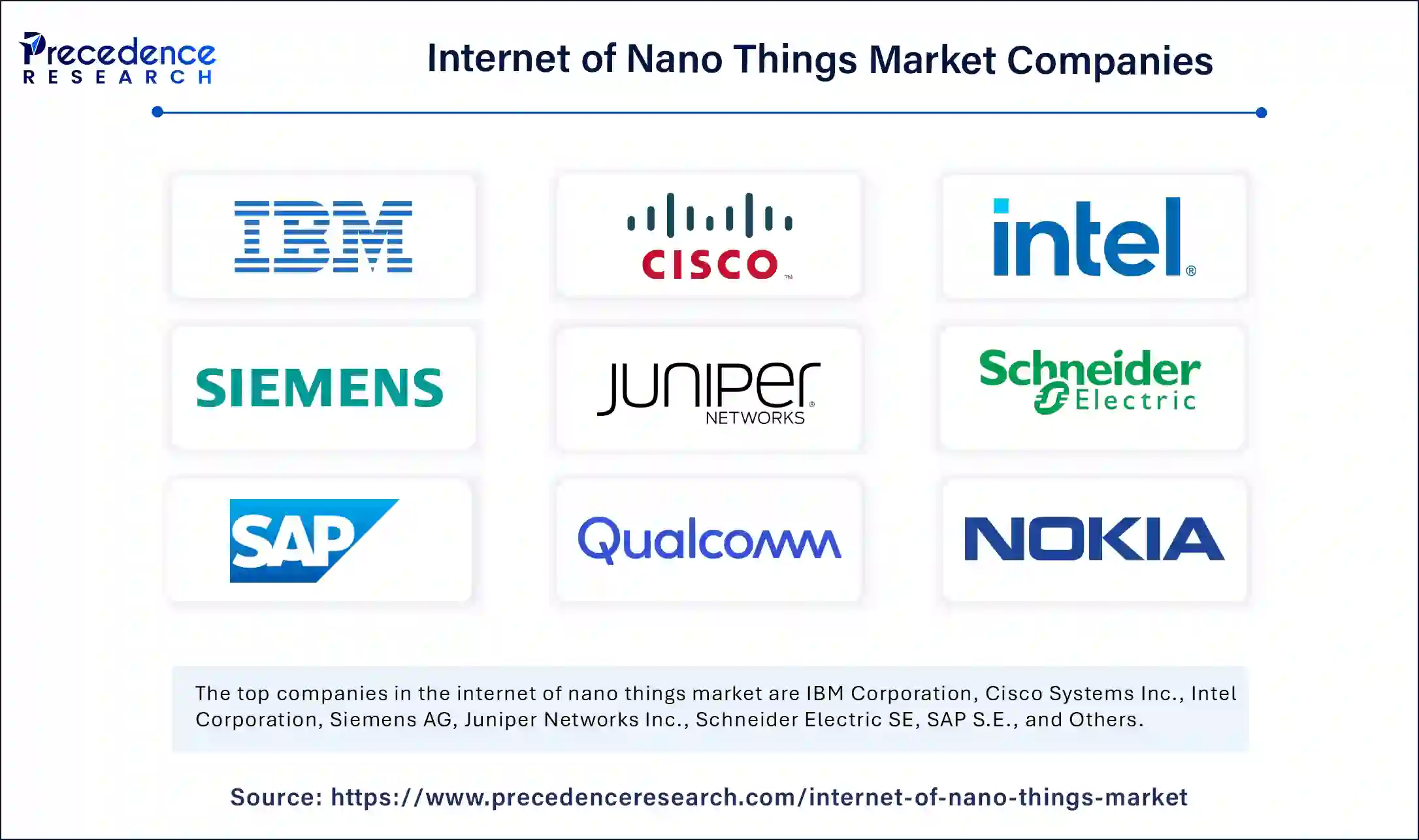July 2024
The global Internet of Nano Things market size is calculated at USD 26.91 billion in 2025 and is forecasted to reach around USD 123.32 billion by 2034, accelerating at a CAGR of 18.43% from 2025 to 2034. The market sizing and forecasts are revenue-based (USD Million/Billion), with 2024 as the base year.
The global Internet of Nano Things market size was calculated at USD 22.72 billion in 2024 and is predicted to increase from USD 26.91 billion in 2025 to approximately USD 123.32 billion by 2034, expanding at a CAGR of 18.43% from 2025 to 2034. The market is expanding due to factors like increasing connectivity among existing devices, applications of the Internet of Nano Things (IoNT) in leading sectors due to its robust security provision, and a medium to transfer data by adding nano-devices to the current ecosystem of the market.

The Internet of Nano Things market is revolutionized by the integration of cutting-edge technologies such as artificial intelligence with IoNT, which creates vast possibilities for the future. Standardized industrial protocols like PROFITNET and Modbus by IEC are helping the market to grow as more reliable and secure industrial adoption. Moreover, by leveraging 5G New Radio standards, the adoption and development of ultra-reliable, low-latency communication and vehicles for everything are possible while creating new avenues for the market to expand. Such advancements are cornerstones in the market that enable manufacturing facilities to produce high-quality products that lower costs and maintain agile operations and flexible production possibilities.
The Internet of Nano Things market is expanding owing to innovations occurring in the nanotechnology sector that are applicable in various fields. The integration of nanotechnology with established communication infrastructure has accelerated the use of sophisticated nano-devices ranging from 1-100 nanometres, which is revolutionizing existing industrial processes. Additionally, the integration of IoNT with cutting-edge and evolving technologies like big data, cloud computing, and machine learning is setting new avenues for smart infrastructure development and automation in industrial processes.
Region-wise, North America dominated the global Internet of Nano Things market, while Asia Pacific is registering as the fastest-growing region. The growth of this region can be attributed to factors like government initiatives to develop the nanotechnology field and integration of IoNT with various other domains like healthcare, telecommunication, and supply chain management. IoNT technologies found extensive applications in the development of smart infrastructure, particularly for city planning initiatives.
Another significant adopter of the Internet of Nano Things is the healthcare sector. Nearly 73% of healthcare organizations use IoNT for monitoring and maintenance, clearly showcasing its utility in the healthcare domain. Similarly, the industrial transformation is occurring due to the integration of the Internet of Things (IoT), such as developing communication protocols and standards set for nano-scale devices, which fortify reliable data transmission across diverse networks.
| Report Coverage | Details |
| Market Size by 2034 | USD 123.32 Billion |
| Market Size by 2025 | USD 26.91 Billion |
| Market Size in 2024 | USD 22.72 Billion |
| Market Growth Rate from 2025 to 2034 | CAGR of 18.43% |
| Leading Region | North America |
| Fastest Growing Market | Asia Pacific |
| Base Year | 2024 |
| Forecast Period | 2025 to 2034 |
| Segments Covered | Device Type, Communication Type, Network Architecture, End User, and Regions |
| Regions Covered | North America, Europe, Asia-Pacific, Latin America, and Middle East & Africa |
Expansion of connected devices ecosystems
The significant driving factors for the Internet of Nano Things market are the expansion of connected devices and improvement in connectivity technologies. The innovation in secure and fast-paced 5G connectivity is escalating more precise applications across various industries, further supporting automated warehouses, connected logistics, product handling, and autonomous processes.
Additionally, the rapid advancement in nano trends is transforming various industries like healthcare and manufacturing. This trend was further amplified when, in 2023, Intel announced their innovative 1.8 nm production process in collaboration with Arm to develop a low-power compute system on chips for applications from diverse sectors like automotive to aerospace.
Substantial investment
The major restraining factor that the Internet of Nano Things market holds is the huge capital investments in the initial stages and compatibility failure. Compatibility is a major challenge for developing medical nanosensors. Developers must ensure that nanosensors will not have any side effects on patients' treatment, along with uninterrupted connectivity. To achieve this target, designers and developers should look for materials that are skin-friendly and compatible with the human body. However, searching for such materials is quite a tough task and will require extensive testing, which further leads to complications in the process and is time-consuming.
Expansion of IoT and huge demand for IoNT by end users
The major opportunity that helps the Internet of Nano Things market to grow is the rapid expansion of IoT and increasing demand for IoNT by various end-use industries. The rapid development of IoT is expected to have a huge impact on the IoNT market as it escalates the demand for nanomaterials and nanotechnology-based solutions. Moreover, the manufacturing sector is transforming to self-operated, high bandwidth devices used for AI, IoT, and advanced manufacturing by employing autonomous and embedded sensors with the help of a combination of micro and nano system technologies. It will surely expand the possibility of the Internet of nano things in various sectors over the next few years.
The nanosensors segment is estimated to hold the largest Internet of Nano Things market share. The growth of this segment is primarily due to its extensive application across various industries. The sensors play a pivotal role in collecting and transmitting data at the nanoscale, which is helpful for accurate and efficient monitoring. The healthcare sector is also significantly impacted by the incorporation of nanosensors for patient monitoring and diagnostics processes. Increasing demand for precise real-time data acquisition in various fields like manufacturing, agriculture, and smart cities reinforced the segment's dominance in the global market.
The nano-camera segment will show notable growth in the coming years. Cameras are an integral part of the internet of nano things system, and they can be used in several fields where high resolution is mandatory at the microscopic level, such as medical diagnosis. In the security and surveillance sector, nano cameras offer advanced monitoring systems as they have compact size and high-resolution characteristics. The ongoing research in this segment expands its applicability in many fields.
The short-distance segment held the largest Internet of Nano Things market share in 2024. The segment is propelling due to its extensive applications where close range, low power, and secure data are needed.NFC zig-bee, femtocell, and Li-Fi are some examples of short-distance communication technologies. NFC is mainly used as a contactless payment method for secure data transformation. Zig-bee has a primary role in home automation and industrial settings owing to its lower power consumption and reliable connectivity. Similarly, Li-Fi is gaining traction with many consumers due to its ability to use light to transfer data at a higher speed.
The large distance segment registers as the fastest-growing segment in the forecast period. Wi-Fi and radio frequency identification are significant components of the IoNT market. Wi-Fi is a popular choice among consumers due to its widespread availability and capacity to support high data rates, which is helpful in the transmission of larger volumes of data over a longer distance. RFID is more useful in asset tracking, providing a reliable method to identify and track goods from a long distance.
The nano-nodes segment dominated the global Internet of Nano Things market in 2024. Nano-nodes can be defined as a basic part of the IoNT infrastructure, which acts as data collection points. Nodes are basically equipped with sensors and other nano-scale devices to collect data from the environment and transfer it to further action. The segment is expanding due to characteristics of nano-nodes like small size, lesser power consumption, and capability to work in challenging environments.
The nano routers segment will witness considered growth during the studied period. Nano-routers are an essential part of the IoNT structure to manage data traffic and ensure efficient communication within the nano-network. Such devices are mediators transmitting signals from one node to other devices. They are crucial to maintaining integrity and performance networks in complex environments like large numbers of interconnected devices. Challenges in nano-scale communication, like signal attenuation and interference, make it crucial for the scalability and performance of IoNT networks.
In 2024, the healthcare segment held the dominating share of the Internet of Nano Things market. This segment is dominant in the market due to the significance of IoNT, which is revolutionizing the medical sector in diagnosis and patient monitoring. Nanodevices, such as sensors and drug delivery systems, are helpful in improving patient care and outcomes. These systems enable real-time monitoring of vital signs like heart rate, blood pressure, SPo2, and brain function. To reduce recovery time and enhance precision in advanced diagnostic procedures and in minimally invasive surgeries, the IoNT plays a crucial role in achieving this.
The transportation and logistics segment will grow significantly during the forecast period of 2025-2034. The growth of this segment is due to extensive applications of IoNT in optimizing supply chain operations, improving overall safety, and enhancing vehicle performance. Nanosensors can provide crucial data about fuel consumption and engine performance for predictive maintenance. IoNT further helps in the real-time tracking of goods for efficient inventory management and quality control.
North America accounted for the largest share of the Internet of Nano Things market in 2024. The growth of this region is majorly due to its advanced technological infrastructure, huge investment in research and development, and the presence of leading market players. Specialties like the robust healthcare sector, strong backup for the defense and aerospace industry, and adoption of IoNT in sectors like manufacturing and transportation are responsible for market expansion, specifically enabled by United States contributions. Some other factors that help in market expansion include funding in nanotechnology and IoT, supportive government policies, and a regional focus on innovation, leading the region. The robust telecommunications and IT infrastructure also helps the rapid deployment and integration of IoNT technologies in diverse fields.
Asia Pacific will host the fastest-growing Internet of Nano Things market during the forecast period. The market is driven by various reasons, including the invasion of the internet in emerging Asian countries like India, China, and Japan and technological advancements like the implementation of 5G, established telecommunications infrastructure, and industrial growth in the leading countries. Deployment of IoNT is propelling in the Asia Pacific due to increasing focus on smart cities and environmental monitoring in the region, enabling growing demand for IoNT solutions in major sectors. In addition to this, by recognizing the potential of IoNT and its possible applications in diverse fields, governments of leading countries are investing heavily in research and development for IoNT along with nanotechnology, further helping the market to grow significantly in the Asia Pacific.

By Device Type
By Communication Type
By Network Architecture
By End User
By Regions
For inquiries regarding discounts, bulk purchases, or customization requests, please contact us at sales@precedenceresearch.com
No cookie-cutter, only authentic analysis – take the 1st step to become a Precedence Research client
July 2024
January 2025
December 2024
December 2024